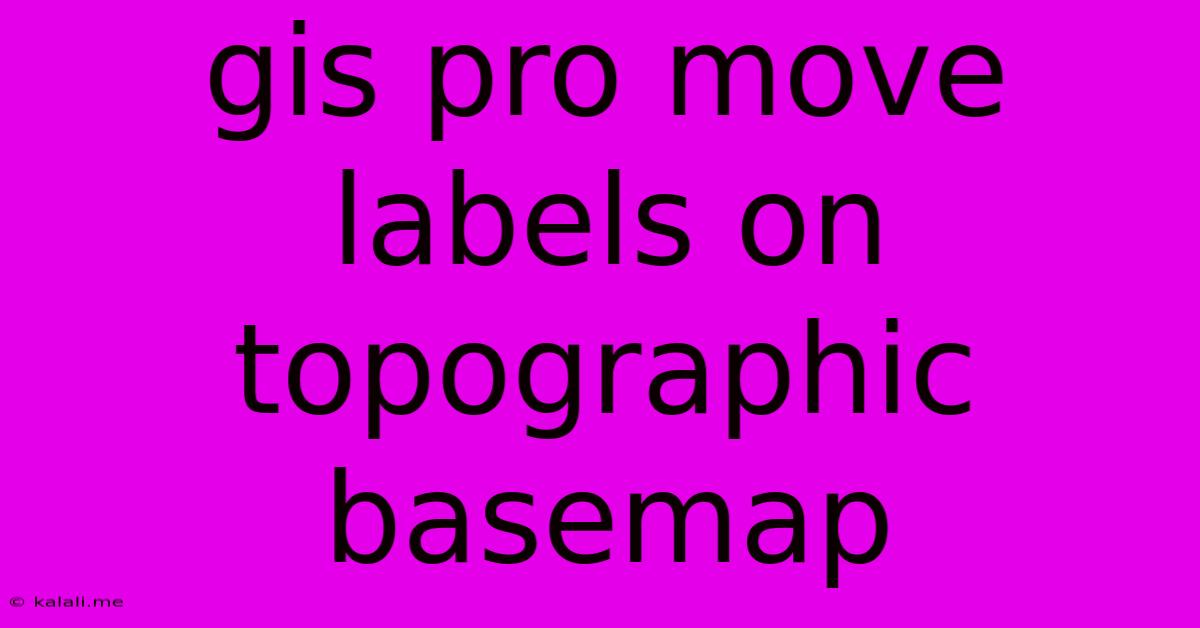Gis Pro Move Labels On Topographic Basemap
Kalali
Jun 06, 2025 · 3 min read

Table of Contents
GIS Pro: Mastering Label Placement on Topographic Basemaps
This article delves into the intricacies of effectively placing labels on topographic basemaps within GIS Pro, focusing on strategies for clear, readable, and aesthetically pleasing map outputs. We'll cover techniques for optimizing label placement to avoid overlaps and enhance overall map readability, crucial for both print and digital map products. Understanding these techniques is essential for creating professional-quality GIS maps.
Understanding the Challenges of Label Placement on Topographic Maps
Topographic maps, with their intricate detail of elevation, terrain, and hydrological features, present unique challenges for label placement. Dense feature sets and varying terrain can lead to label overlap and illegibility if not carefully managed. Simply placing labels without consideration for their surroundings often results in a cluttered and confusing map. This is especially true when dealing with a high density of point features like buildings or elevation points in urban areas.
Key Strategies for Effective Label Placement in GIS Pro
GIS Pro offers a powerful suite of tools to manage label placement. The key is to strategically leverage these tools and understand the underlying principles to achieve optimal results.
1. Choosing the Right Label Placement Method
GIS Pro provides several label placement methods, each with its strengths and weaknesses. Experimentation is key to finding the best approach for your specific data and map requirements.
- Standard Placement: This is the default method, often sufficient for simpler datasets. However, it can lead to overlaps in complex situations.
- Curved Labels: Ideal for following the curvature of lines, such as roads or rivers, significantly improving readability.
- Point Placement with Offset: This allows precise control over the position of labels relative to the feature point. Useful for avoiding overlaps with other features.
- Polygon Centroid Placement: Places labels at the geometric center of polygons, useful for administrative boundaries or land parcels. However, this might not always be the most visually appealing option.
2. Managing Label Overlaps and Conflicts
Overlap is the enemy of clear cartography. GIS Pro provides several tools to address this:
- Label Prioritization: Assign priorities to different layers to ensure critical information is always visible, even if it means obscuring less important labels.
- Label Buffering: Create a buffer around labels to prevent overlaps with nearby features. Adjust the buffer size to find the optimal balance between label visibility and map clarity.
- Label Expression: Use custom expressions to conditionally display labels, or to modify label text based on feature attributes, preventing unnecessary clutter.
3. Optimizing Label Style and Size
Visual aspects significantly impact readability. Careful consideration of these elements is crucial:
- Font Selection: Choose legible fonts, prioritizing clarity over aesthetics. Serif fonts can be more readable for small labels, while sans-serif fonts are better for larger labels.
- Font Size: Balance font size with label density. Too large, and labels will overlap; too small, and they become illegible.
- Label Color and Background: Use contrasting colors to ensure readability against the basemap. Consider using a background halo or buffer to increase contrast and readability against complex backgrounds.
4. Utilizing Advanced Label Engine Features
GIS Pro's advanced labeling engine offers additional fine-tuning:
- Label Stacking: Stack labels vertically to conserve space, particularly useful in dense areas.
- Label Rotation: Rotate labels to align with features for improved clarity and visual appeal.
- Label Callout: Use callouts to connect labels to their corresponding features, especially helpful for point features close together.
Conclusion: Towards Professional-Quality Topographic Maps
Creating professional-quality topographic maps in GIS Pro requires a methodical approach to label placement. By understanding the challenges, mastering the available tools, and carefully considering both technical and aesthetic aspects, you can create clear, readable, and visually appealing maps that effectively convey geographic information. Remember, practice and experimentation are key to refining your skills and achieving optimal results. Continuous improvement in label placement will significantly enhance the overall quality and effectiveness of your GIS products.
Latest Posts
Latest Posts
-
Replace Exterior Door Threshold On Concrete
Jun 07, 2025
-
Do You Have To Replace Rotors With Brake Pads
Jun 07, 2025
-
What Does Applesauce Mean In 1920s Slang
Jun 07, 2025
-
Sorcery That Lets You Teleport Ot The Side Of Person
Jun 07, 2025
-
What Does The J In Ssj Mean
Jun 07, 2025
Related Post
Thank you for visiting our website which covers about Gis Pro Move Labels On Topographic Basemap . We hope the information provided has been useful to you. Feel free to contact us if you have any questions or need further assistance. See you next time and don't miss to bookmark.